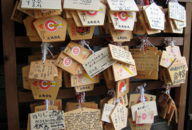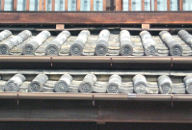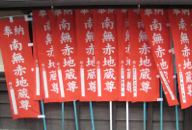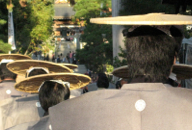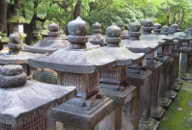LAND OF THE RISING SUN
The islands of japan
October 1 - November 17, 2007 & april 14 - 18, 2008


LAND OF THE RISING SUN
The islands of japan
October 1 - November 17, 2007 & april 14 - 18, 2008




Nippon is the Japanese word for Japan. In Japanese calligraphy, the characters that make up Japan’s name mean “sun origin” since it lies east of the nearby countries of China, Korea, Taiwan and Russia, causing it to be referred to as “Land of the Rising Sun”. Japan is an archipelago of 6,852 islands, with the four largest (Honshu, Hokkaido, Kyushu, and Shikoku) making up 97% of the land mass of the country. Most of the islands are mountainous, with the volcano Mount Fuji as the highest peak. These islands were peopled as early as the Paleolithic period c. 30,000 BC with Chinese texts referring to the islands as early as the 1st century AD. Over the centuries, Japan’s history could be characterized by outside influence followed by long periods of isolation. Since the adoption of its pacifist constitution in 1947, Japan has maintained a unitary constitutional monarchy with an emperor and an elected parliament called the Diet. The power of the Emperor is limited, with Emperor Akihito and Empress Michiko, the ceremonial figureheads defined by the constitution as“symbols of state and the unity of the people” in what is the oldest continuous hereditary monarchy in the world. Though the Emperor effectively acts as head of state on diplomatic occasions, the Prime Minister of Japan is head of the government. The Prime Minister’s position is appointed by the Emperor of Japan after being designated by the Diet from among its members, holds office only as long as confidence of the Representatives to remain. Naruhito, the Crown Prince of Japan stands next in line to the throne. Japan is a world economic power, third in line after the United States and China. Highlights of Japan’s history include:
•YAYOI PERIOD c. 500 BC- Introduction of several new practices including wet rice farming, pottery and metallurgy brought by migrants from China and Korea.
•ASUKU PERIOD c. 6th century: 538-710 AD Buddhism was first introduced to Japan from Korea, then later was influenced by China. Prince Shoktoku’s Constitution of 17 Articles was promulgated.
•NARA & HEIAN PERIODS c. 8th - 12th centuries: 710-1185 marked the emergence of a strong central Japanese state as an imperial court in Nara. It also was a period of birth of written literature and massive chronicle. The Emperor Kammu moved the capital from Nara in 784, then briefly to Nagaoka and finally to Heian-kyo or the present day Kyoto. in 794, where it remained for a thousand years. During this period a distinctly indigenous Japanese culture emerged, noted for its art, poetry, and literature. The Tale of Genji and the lyrics of modern Japan’s national anthem, Kimi ga Yo were written during this time.
•KAMAKURA PERIOD c. 12th-14th centuries: 1191-1333. Japan’s feudal era was characterized by the emergence of a feudal class of warriors, the samurai. In 1185 with the defeat of the rival Taira clan, Minamoto no Yoritomo was appointed Shogun, establishing a base in Kamakura. After his death, the Hojo clan became the rulers as regents for the shoguns. During the Kamakura Period, Zen Buddhism, introduced from China, became popular amongst the samurai class. The Kamakura shogunate managed to repel the Mongol invasions in 1274 and 1281, aided by a storm that the Japanese interpreted as a kamikaze or “Divine Wind”.
•MUROMACHI & SENGOKU PERIODS: 14th early 16th centuries: 1334-1573: (THE “Warring States Period”). Emperor Go-Daigo overthrew the Kamakura shogunate. He was then defeated by Ashikaga Takauji in 1335 and fled Kyoto, establishing the Southern Court in Yoshino. Takauji then estabished the Muromachi government and a second Northern Court in Kyoto. Takauji failed to control the daimyo or feudal warlords and a civil war erupted. The Onin War of 1467 ushered in the century-long Sengoku Period.
•In 1542, Portuguese traders and Jesuit missionaries from Portugal reached Japan for the first time, initiating active commerce and cultural exchange between Japan and the West. They also introduce Christianity to Japan. Portuguese firearms in the form of muskets were sold and traded to the Japanese, aiding Oda Nobunaga to conquer numerous other daimyo. Nobunaga entered Kyoto and the Muromachi Bakufu fell.
•AZUCHI MOMOYAMA PERIOD: c. 16th century: 1573-1603 Century Nobunga had almost unified the nation by the time he was assassinated in 1582. Toyotomi Hideyoshi succeeded Nobunaga and unified Japan in 1590. Hideyoshi invaded Korea twice, but the Japanese troops were withdrawn from Korea after several defeats and Hideyoshi’s death in 1598. Tokugawa Jeyasu utilized his position as regent for Hideyoshi’s son, Toyotomi Hideyori to gain political and military support. When open war broke out, he defeated rival clans in the Battle of Sekigahara in 1600. Jeyasu was appointed shogun in 1603 and established the Tokugawa shogunate at Edo (modern Tokyo). The Tokugawa shogunate enacted a variety of measures such as Buke shohatto to control the autonomous daimyo. This was a period of prosperity and the opening of Japanese trade with China.
•EDO PERIOD c. 17th - mid-19th centuries: 1603-1867 Beginning in 1614, Tokugawa Jeyasu intensified the persecution of Christians. His capture of Osaka Castle in 1615 destroyed the Toyotomi clan. 1639 marked the beginning of the shogunate isolationist sakoku or “closed country”, a policy spanning two and a half centuries of tenuous political unity. Between 1688-1703, Genroku or popular culture flourished. In 1792, the Russians tried unsuccessfully to establish trade relations with Japan. In 1854 with the arrival of Commodore Matthew Perry and the “Black Ships” of the United States Navy forced the opening of Japan to the outside world with the Convention of Kanagawa.
•MEIJI RESTORATION c. Late 19th & Early 20th centuries: 1868-1912 Japan adopted Western political, judicial, and military institutions. The Cabinet organized the Privy Council, introduced the Meiji Constitution, and assembled the Imperial Diet. The Meiji Restoration transformed the Empire of Japan into an industrialized world power that embarked on a number of military conflicts to expand the nation’s sphere of influence. Victories in the First Sino-Japanese War (1894-95) and the Russo-Japanese War (1904-05) helped Japan gain control of Taiwan, Korea, and the southern half of Sakhalin. Japan’s population doubled from 35 million in 1873 to 70 million in 1935.
•TAISHO DEMOCRACY AND THE EMPIRE OF JAPAN. In the early years of the 20th century, a brief period of democracy was soon overshadowed by its militarization and expansionism. Japan joined the side of the victorious Allies during WW I, expanding its influence and territorial holdings. It continued its expansionist policy when it occupied Manchuria in 1931. When the international community condemned this occupation, Japan resigned from the League of Nations. It signed the Anti-Comintern Pact with Nazi Germany in 1936. In 1937, the Empire of Japan invaded other parts of China, precipitating the Second Sino-Japanese War (1937-1945). In 1940, the Empire invaded French Indochina, after which the United States placed an oil embargo on Japan. Japan joined the Axis Powers in 1941, the same year it signed the Soviet-Japanese Neutrality Pact with the Soviet Union, respecting the Manchukuo and the Mongolian People’s Republic territories.
•MID 20TH CENTURY AND WORLD WAR II. On December 7, 1941 Japan attacked the United States naval base in Pearl Harbor, Hawaii and declared war on the United States, the United Kingdom, and the Netherlands. This act brought the United States into World War II and, on December 8th, these three countries declared war on Japan. After the atomic bombings of Hiroshima and Nagasaki in 1945, along with the Soviet Union joining the war against it, Japan agreed to an unconditional surrender of all Japanese forces on August 15th, 1945 as Victory over Japan Day.
•POST WW II. The war cost Japan and the Greater East Asia Co-Prosperity Sphere millions of lives, plus destroyed Japan’s industries and infrastructure. The International Military Tribunal for the Far East, convened by the Allies on May 3, 1946 to prosecute some Japanese leaders for war crimes. All members of the bacteriological research units and members of the imperial family involved in the conduct of war were exonerated from criminal prosecutions by the Supreme Commander of the Allied Forces, General Douglas MacArthur. The Allied occupation ended with the Treaty of San Francisco in 1952. Japan became a member of the United Nations in 1956 and later achieved spectacular growth to become the second largest economy in the world, with an annual growth rate averaging 10% in four decades. In the mid-1990’s, Japan suffered a major recession and a major earthquake in Kobe. It also has the largest military spending in the world, available only for defensive purposes as described by their constitution.
PHOTOS: Left Column: 1. A traditional Japanese umbrella made of paper. 2. Shoes of the Zen Buddhist Master in an annual ceremony at Kencho-ji Temple in Kamakura. 3. Marchers in Edo Period costume at the Autumn Festival parade in Takayama. 4. Banners at the Shingon Buddhist Teaching Center in Koyasan. Center: A ceremonial dancing lion, the animation created by two dancers in the parade of the Autumn Festivities in Takayama. Right Column: 1. Street scene with Japanese lanterns, Takayama. 2. Edo Period tile roof. 3. Handwritten prayer tablets at a temple in Kamakura. 4. The Red Jizo, a Buddha figure, in Koyasan.

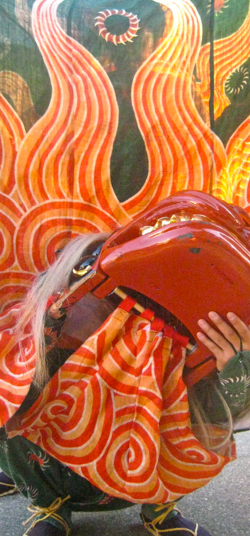
Nippon
